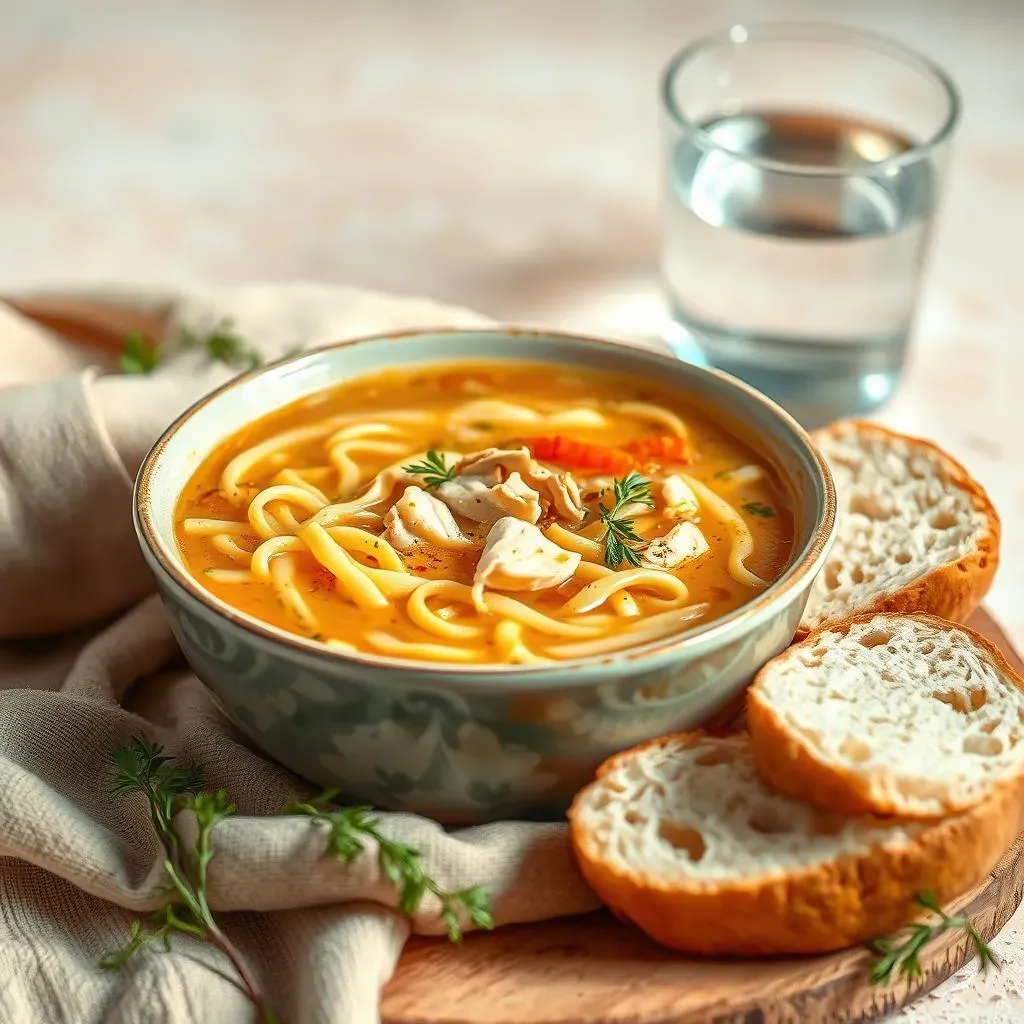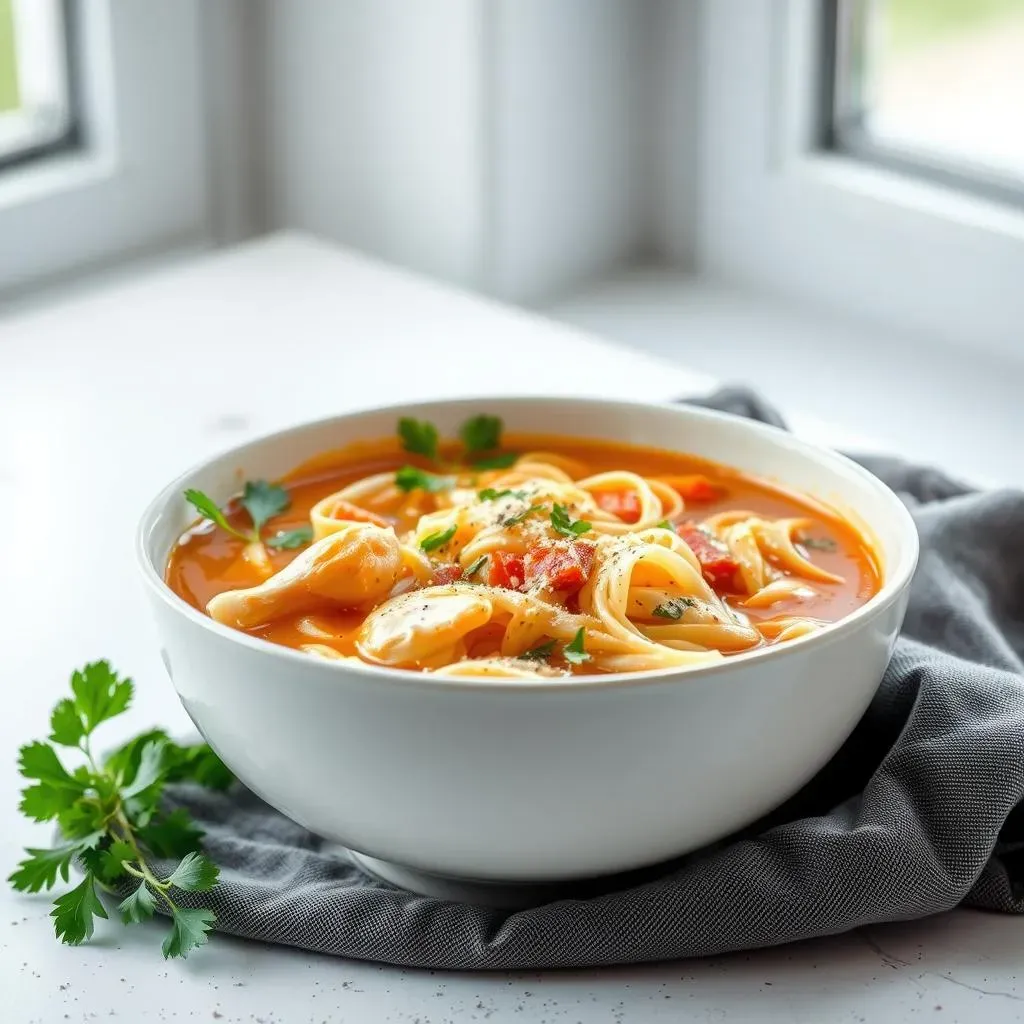Table of Contents
If you've had bariatric surgery, you might be missing some of your old comfort foods. Chicken noodle soup is often at the top of that list. It's warm, it's soothing, and it just feels like home, doesn't it? But, the regular version might not be the best choice after your procedure. That's where this article comes in! We're going to explore how to make chicken noodle soup for bariatric patients that’s both delicious and safe. This isn't just about cutting out noodles; it's about making smart choices to get all the good stuff your body needs while still enjoying a classic meal. We'll cover the whys, the hows, and the best ways to adapt this favorite. From the key adjustments you need to make, to a simple high-protein recipe, and finally some tips to make sure you enjoy it safely. So get ready to rediscover chicken noodle soup, the bariatric-friendly way!
Why Chicken Noodle Soup is Great After Bariatric Surgery

Why Chicken Noodle Soup is Great After Bariatric Surgery
Okay, so you've had bariatric surgery, and things are different now, right? One of the biggest shifts is how you eat. That's where chicken noodle soup comes in as a bit of a superstar. First off, it's gentle on your stomach. After surgery, your tummy can be super sensitive, and this soup is like a warm hug for it. It's not heavy or hard to digest, which is exactly what you need when you're healing. Plus, it's a fantastic way to get fluids in. Staying hydrated is key, especially in the early days post-op, and a flavorful broth does the trick. But it is not just about being easy to eat, it's also a sneaky way to pack in some protein, which is super important for healing and keeping your energy up. So, chicken noodle soup isn't just comfort food; it’s actually a really smart choice to help you recover.
Making Chicken Noodle Soup BariatricFriendly: Key Adjustments

Making Chicken Noodle Soup BariatricFriendly: Key Adjustments
The Noodle Situation
Okay, let's be real, the noodles are usually the star of the show in chicken noodle soup, right? But after bariatric surgery, they can be a bit of a no-go. They're often high in carbs and don't offer much in the way of protein or nutrients. So, what do we do? We ditch 'em, or at least, we swap them out. Think about it: instead of regular wheat noodles, we can try zucchini noodles (zoodles), or even shredded cabbage, which adds a nice crunch. These give you that satisfying "noodle" feel without the carb overload. It's all about making those smart swaps that keep you on track without feeling like you're missing out on anything.
Another big change is the size of the portions. After surgery, you're eating smaller meals, so you've got to think about making each bite count. That means focusing on the good stuff: lean protein and lots of veggies.
Protein Power-Up
Now, let's talk about protein. It’s the real hero here. It’s not just about having chicken; it's about choosing the right kind and making sure you get enough. Lean chicken is your best friend, like boneless, skinless chicken breast or thigh. And you don't want big chunks, either. Think small, shredded pieces that are easy to manage. We can even boost the protein by adding a scoop of unflavored protein powder to the broth, which is a game-changer. This way, you're not only getting the comfort of the soup but also a serious protein punch to help you heal and feel full longer. It's like giving your soup a super-powered upgrade.
Lastly, don’t forget about the veggies. They add flavor, nutrients, and fiber, which is good for your digestion. Carrots, celery, and onions are classics, but feel free to experiment with other veggies like spinach or bell peppers, depending on what your stomach can handle. Just be sure to chop them up nice and small for easier digestion.
Adjustment | Why it's Important | How to do it |
|---|---|---|
Noodles | High in carbs, low in nutrients. | Swap for zoodles, shredded cabbage, or other low-carb alternatives. |
Protein | Essential for healing and satiety. | Use lean, shredded chicken, add protein powder to broth. |
Portion Size | Smaller stomach needs smaller meals. | Use smaller bowls, focus on protein and veggies. |
Veggies | Add nutrients and fiber. | Add a variety of chopped veggies. |
A Simple Recipe for HighProtein Chicken Noodle Soup

A Simple Recipe for HighProtein Chicken Noodle Soup
Gathering Your Ingredients
Alright, let’s get cooking! This recipe is all about keeping it simple and packing in the good stuff. You'll need about 1 pound of boneless, skinless chicken thighs – they tend to stay moister than breasts, which is great. Then grab 4 cups of low-sodium chicken broth, 1 cup of chopped veggies (carrots, celery, and onions work wonders), and about 2 cups of your chosen noodle alternative – zoodles, cabbage, whatever you fancy. Don't forget a tablespoon of olive oil for sautéing, and some salt, pepper, and any other seasonings you love. A little garlic powder or some fresh herbs can really elevate the flavor. And, if you're feeling extra protein-y, have that unflavored protein powder ready.
Before we start, a quick note: make sure all your veggies are chopped nice and small. This not only helps with digestion but also makes it easier to eat. And for the chicken, we’re going to shred it after it's cooked. Small pieces are key here. It's all about making this soup as easy and comfortable as possible for your post-surgery tummy.
Step-by-Step Cooking Instructions
First, let's get the flavors going. Heat the olive oil in a large pot over medium heat. Toss in your chopped veggies and sauté them for about 5 minutes, until they start to soften. Next, add the chicken broth and bring it to a gentle simmer. Now, carefully add the chicken thighs to the pot. Let them cook for about 15-20 minutes, or until they're cooked through. Once the chicken is done, take it out of the pot and shred it using two forks. It should be nice and tender. Put the shredded chicken back into the pot. If you're using protein powder, now's the time to stir it in until it's completely dissolved.
Finally, add your noodle alternative to the soup. If you're using zoodles, they'll only need a few minutes to cook. If you're using cabbage, it might need a bit longer. Simmer for another 5-10 minutes, or until your "noodles" are tender. Give it a taste and season with salt, pepper, and any other herbs you like. And there you have it: a warm, comforting, and protein-packed bowl of chicken noodle soup that’s perfect for your needs.
Step | Action | Time |
|---|---|---|
1 | Sauté veggies | 5 minutes |
2 | Add broth and chicken | 15-20 minutes |
3 | Shred chicken | 5 minutes |
4 | Add "noodles" and protein powder (if using) | 5-10 minutes |
Tips for Enjoying Your Chicken Noodle Soup Safely

Tips for Enjoying Your Chicken Noodle Soup Safely
Start Slow and Listen to Your Body
Alright, you've made your awesome bariatric-friendly chicken noodle soup, but hold your horses! It's super important to not just dive in headfirst. Remember, your tummy is still healing. So, the first rule of soup club is: start slow. Begin with a small portion, maybe just a half cup, and see how you feel. Don't try to finish the whole bowl in one go, no matter how tempting it may be. Pay close attention to how your body reacts. Are you feeling full quickly? Are you experiencing any discomfort or nausea? These are all signals that you need to heed. It's not a race; it's about nourishing your body and enjoying the meal without any issues. Think of it as a gentle reintroduction to solid foods.
Another crucial thing is to eat slowly. I mean, really slowly. Put down your spoon between bites, chew thoroughly, and savor each mouthful. This is not just about being polite; it's about giving your stomach time to process the food and signal when it's had enough. It also helps prevent that uncomfortable feeling of being overly full, which is something you definitely want to avoid. Think of each spoonful as a mini-meal, and give it the attention it deserves. This mindful approach to eating is key to your post-surgery success.
Watch Out for Triggers and Textures
Okay, let's talk about potential pitfalls. After bariatric surgery, some foods might not sit well with you, and it's different for everyone. Some people might find that certain vegetables, like onions or celery, can cause discomfort or gas. If you notice that, don't be afraid to adjust your recipe. Maybe try other veggies or cook them down a bit more. Also, pay attention to textures. Some people find that very chunky or fibrous foods can be difficult to digest. If that's you, consider pureeing your soup or blending it to get a smoother consistency. This can make it easier for your stomach to handle. It's all about experimenting and finding what works best for you.
Finally, keep a food journal. I know, it sounds a bit tedious, but it can be a game-changer. Jot down what you ate, how much, and how you felt afterward. This can help you identify any trigger foods or specific ingredients that don't agree with you. It also helps you track your progress and make adjustments as needed. It's like having a personal food detective, helping you navigate your new eating habits with confidence. And remember, you're not alone in this; there's a whole community of people going through similar experiences. So, reach out, share your tips, and learn from others. It's all part of the journey.
Tip | Why it's Important | How to Implement |
|---|---|---|
Start Slow | Avoid overwhelming your stomach. | Begin with small portions, eat mindfully. |
Listen to Your Body | Identify discomfort or nausea. | Pay attention to fullness, adjust accordingly. |
Watch for Triggers | Identify foods that cause discomfort. | Experiment with different veggies and textures, puree if needed. |
Keep a Food Journal | Track progress and identify trigger foods. | Note what you eat and how you feel after. |
